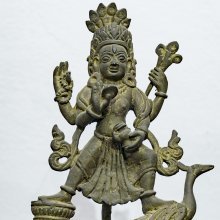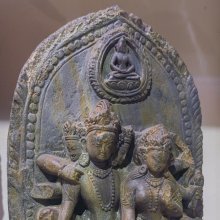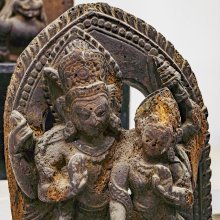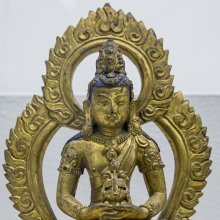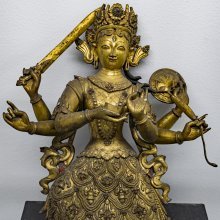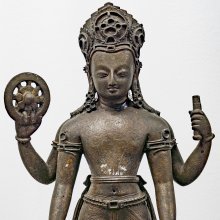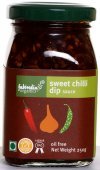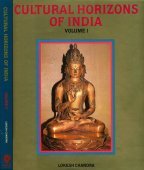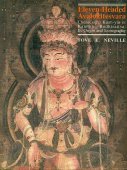Tai, Tāī, Ṭai: 8 definitions
Introduction:
Tai means something in the history of ancient India, Marathi, Jainism, Prakrit, Hindi, biology, Tamil. If you want to know the exact meaning, history, etymology or English translation of this term then check out the descriptions on this page. Add your comment or reference to a book if you want to contribute to this summary article.
Images (photo gallery)
(+3 more images available)
India history and geography
Source: Shodhganga: Temples and cult of Sri Rama in Tamilnadu (history)Tai refers to the month in the Tamil tradition corresponding to the months January-February.—[Festivals of Tai are: Ponkal, the Festival of the Tamils]—Festivals take place in all Tamil moths of the year, beginning with Cittirai (April-May) and ending with Pankuni (March-April).—The rules and regulations for daily offerings and the periodical festivals [viz., Tai] are laid down in the Agamas.

The history of India traces the identification of countries, villages, towns and other regions of India, as well as mythology, zoology, royal dynasties, rulers, tribes, local festivities and traditions and regional languages. Ancient India enjoyed religious freedom and encourages the path of Dharma, a concept common to Buddhism, Hinduism, and Jainism.
Biology (plants and animals)
Source: Google Books: CRC World Dictionary (Regional names)1) Tai in India is the name of a plant defined with Alternanthera sessilis in various botanical sources. This page contains potential references in Ayurveda, modern medicine, and other folk traditions or local practices It has the synonym Illecebrum sessile Pall. ex Moq. (among others).
2) Tai is also identified with Cleome gynandra It has the synonym Gynandropsis palmipes DC. (etc.).
3) Tai is also identified with Oryza sativa It has the synonym Oryza sativa var. affinis Körn. (etc.).
Example references for further research on medicinal uses or toxicity (see latin names for full list):
· Journal of Ethnopharmacology (2002)
· Journal of Palynology (1980)
· Plant Systematics and Evolution (1993)
· Blumea, Supplement (1946)
· Journal of Botany, British and Foreign (1889)
· Journal of the Asiatic Society of Bengal
If you are looking for specific details regarding Tai, for example extract dosage, chemical composition, diet and recipes, side effects, health benefits, pregnancy safety, have a look at these references.

This sections includes definitions from the five kingdoms of living things: Animals, Plants, Fungi, Protists and Monera. It will include both the official binomial nomenclature (scientific names usually in Latin) as well as regional spellings and variants.
Languages of India and abroad
Marathi-English dictionary
Source: DDSA: The Molesworth Marathi and English Dictionarytāī (ताई).—f A term of respectful compellation or mention of a sister or of a female gen. This title, like bāī, mātōśrī, and some others, is often used pl and n. Ex. tāī ālīṃ, tāī gēlīṃ; and, in some districts, these words are pl m.
Source: DDSA: The Aryabhusan school dictionary, Marathi-Englishtāī (ताई).—f A term of respectful mention of a sister, &c
Marathi is an Indo-European language having over 70 million native speakers people in (predominantly) Maharashtra India. Marathi, like many other Indo-Aryan languages, evolved from early forms of Prakrit, which itself is a subset of Sanskrit, one of the most ancient languages of the world.
Hindi dictionary
Source: DDSA: A practical Hindi-English dictionary1) Ṭāī (टाई):—(nf) a necktie.
2) Tāī (ताई):—(nf) father’s elder brother’s ([tāū]'s) wife.
...
Prakrit-English dictionary
Source: DDSA: Paia-sadda-mahannavo; a comprehensive Prakrit Hindi dictionary1) Tai (तै) in the Prakrit language is related to the Sanskrit word: Tadā.
2) Taī (तई) also relates to the Sanskrit word: Trayī.
3) Tāi (ताइ) also relates to the Sanskrit word: Tyāgin.
4) Tāi (ताइ) also relates to the Sanskrit word: Tāyin.
5) Tāi (ताइ) also relates to the Sanskrit word: Tāpin.
6) Tāi (ताइ) also relates to the Sanskrit word: Trāyin.
7) Tāi (ताइ) also relates to the Sanskrit word: Tāyin.
8) Tāi (ताइ) also relates to the Sanskrit word: Trāyin.
Prakrit is an ancient language closely associated with both Pali and Sanskrit. Jain literature is often composed in this language or sub-dialects, such as the Agamas and their commentaries which are written in Ardhamagadhi and Maharashtri Prakrit. The earliest extant texts can be dated to as early as the 4th century BCE although core portions might be older.
Kannada-English dictionary
Source: Alar: Kannada-English corpusTai (ತೈ):—[noun] a rhythmical syllable used in music ad dance to denote a single unit.
Kannada is a Dravidian language (as opposed to the Indo-European language family) mainly spoken in the southwestern region of India.
Tamil dictionary
Source: DDSA: University of Madras: Tamil LexiconṬai (டை) . The compound of ட் [d] and ஐ. [ai.]
--- OR ---
Tai (தை) . The compound of த் [t] and ஐ. [ai.]
--- OR ---
Tai (தை) [taittal] 11 verb [Malayalam: taikka.] transitive
1. To sew, stitch; தையலிடுதல். (சூடாமணிநிகண்டு) [thaiyaliduthal. (sudamaninigandu)]
2. To nail, fasten beams with nails, spikes or pegs; to pin; ஆணிமுதலியன அடித்தல். படத் திற்கு ஆணி தைத்தாயிற்றா? [animuthaliyana adithal. padath thirku ani thaithayirra?]
3. To plait or stitch, as leaves into plate; இலை முதலியன குத்தியிணைத்தல். [ilai muthaliyana kuthiyinaithal.]
4. To join; பொருத்துதல். பலகை தைத்து [poruthuthal. palagai thaithu] (மகாபாரதம் கிருட்டிண. [magaparatham kiruttina.] 102).
5. To pierce, penetrate, prick, as a thorn, an arrow; முண்முதலியன ஊடுருவுதல். மேனிதைத்த வேளசரங்கள் [munmuthaliyana uduruvuthal. menithaitha velasarangal] (கம்பராமாயணம் உலாவியல். [kambaramayanam ulaviyal.] 15).
6. To tie, weave, as a wreath; மாலைதொடுத்தல். தொடலை தைஇய மடவரன் மகளே [malaithoduthal. thodalai thaiiya madavaran magale] (ஐங்குறுநூறு [aingurunuru] 361).
7. To string, as beads; கோத்தல். அவிரிழை முத்தந் தைஇ மின்னுமிழ் பிலங்க [kothal. avirizhai muthan thaii minnumizh pilanga] (பதிற்றுப்பத்து [pathirruppathu] 39, 15).
8. To adorn, decorate; அலங்கரித்தல். தைஇய மகளிர் [alangarithal. thaiiya magalir] (கலித்தொகை [kalithogai] 27, 19).
9. To make, create; நிருமித் தல். வல்லவன் றைஇய பாவைகொல் [nirumith thal. vallavan raiiya pavaigol] (கலித்தொகை [kalithogai] 56).
10. To set, enchase; பதித்தல். திகழொளி முத்தங் கரும்பாகத் தைஇ [pathithal. thigazholi muthang karumbagath thaii] (கலித்தொகை [kalithogai] 80, 4).
11. To place, put, as a mark on the forehead; இடுதல். திலகந் தைஇய தேங்கமழ் திருநுதல் [iduthal. thilagan thaiiya thengamazh thirunuthal] (பத்துப்பாட்டு [pathuppattu] 24).
12. To wear, put on; உடுத்துதல். ஏர்தழை தைஇ [uduthuthal. erthazhai thaii] (கலித்தொகை [kalithogai] 125, 12).
13. To paint; சித்திரித்தல். அணிவரி தைஇயும் [sithirithal. anivari thaiiyum] (கலித்தொகை [kalithogai] 76, 2).
14. To surround, cover, encircle; சூழ்தல். சீர்மிகு முத்தந் தைஇய நார்முடி [suzhthal. sirmigu muthan thaiiya narmudi] (பதிற்றுப்பத்து [pathirruppathu] 39, 16).
15. To make a net; வலைபின்னுதல். [valaipinnuthal.] (W.)
16. To close, shut; அடைத்தல். (யாழ்ப்பாணத்து மானிப்பாயகராதி) [adaithal. (yazhppanathu manippayagarathi)] — intransitive
1. To enter, dart; உட்பிரவேசித்தல். அவ்வழித் தைத்தது பூதம் [udpiravesithal. avvazhith thaithathu putham] (கம்பராமாயணம் திருவவ. [kambaramayanam thiruvava.] 88).
2. To pierce the mind; to rankle; to cause pain; மனத்திலுறைத்தல். அவன் சொன்னசொல் என் மனத் திற் றைத்தது. [manathiluraithal. avan sonnasol en manath thir raithathu.]
3. To alight, rest, as the fascinating looks of an unlucky person; திருஷ்டி படுதல். [thirushdi paduthal.] (W.)
--- OR ---
Tai (தை) noun < தை-. [thai-.]
1. Decoration, embellishment; அலங்காரம். தைபுனை மாது [alangaram. thaipunai mathu] (நிகண்டு [nigandu] M ss.).
2. Sewing; தையல். (தைலவருக்கச்சுருக்கம் தைல.) [thaiyal. (thailavarukkachurukkam thaila.)]
--- OR ---
Tai (தை) noun (Music) Onomatopoeic expression of beating time; ஒரு தாளக்குறிப்பு. (அரு. நி.) [oru thalakkurippu. (aru. ni.)]
--- OR ---
Tai (தை) noun < taiṣī. [Malayalam: tai.]
1. The 9th Tamil month, January-February; ஒரு மாதம். தைஇத்திங்கட் டண்ணிய தரினும் [oru matham. thaiithingad danniya tharinum] (குறுந்தொ. [kuruntho.] 196).
2. Capricorn in the zodiac; மகரராசி. [magararasi.]
3. The 8th nakṣatra. See பூசம். (சூடாமணிநிகண்டு) [pusam. (sudamaninigandu)]
--- OR ---
Tai (தை) noun Young plant or tree; மரக் கன்று. தைத்தெங்கு. [marag kanru. thaithengu.] Nāñ.
--- OR ---
Tai (தை) noun See தைவேளை. (வைத்திய மூலிகை) [thaivelai. (vaithiya muligai)]
Tamil is an ancient language of India from the Dravidian family spoken by roughly 250 million people mainly in southern India and Sri Lanka.
See also (Relevant definitions)
Starts with (+448): Tai ajam, Tai bai bei mu, Tai bai chai hu, Tai bai leng zi qin, Tai bai mei hua cao, Tai hang ju, Tai lu ge dang gui, Tai mak, Tai min suan pan zi, Tai shan qian hu, Tai tuwowj ng xanh, Tai tuwowj thon, Tai tuwowjng aasn, Tai tuwowjng dor, Tai tuwowjng duooi choofn, Tai tuwowjng las hoa, Tai tuwowjng lowsn, Tai tuwowjng nam, Tai tuwowjng xanh, Tai tuwowjng xieem.
Ends with (+2293): Acai-nilaialapetai, Acakkiratai, Acamotai, Acampatai, Acariyan-tiru-atiatai, Acatai, Acattai, Accatai, Accavupatai, Accinatai, Accukkattai, Acirattai, Acitai, Acutai, Acuttai, Acuvakantai, Acuvattai, Adhikarashishtai, Adukkunandiyavattai, Ahtai.
Full-text (+711): Dai, Taippirappu, Vayodha, Taippai, Taipponkal, Taikkurakkan, Tainniratal, Tais, Dhai, Tais-ma, Pani-etirparuvam, Taiyenal, Trayi, Tayin, Trayin, Mang cau dai, Tapin, Tyagin, Sai dai, Wat.
Relevant text
Search found 152 books and stories containing Tai, Tāī, Ṭāī, Taī, Tāi, Ṭai, Thai, Dai, Dhai; (plurals include: Tais, Tāīs, Ṭāīs, Taīs, Tāis, Ṭais, Thais, Dais, Dhais). You can also click to the full overview containing English textual excerpts. Below are direct links for the most relevant articles:
Vietnamese Buddhist Art (by Nguyen Ngoc Vinh)
4. Sculptures in Thailand (Introduction) < [Chapter 4 - The Sculpture and its Reciprocal Influence]
4. Thailand Sculptures (e): Tai Period < [Chapter 4 - The Sculpture and its Reciprocal Influence]
8. Buddhist monuments in Thailand < [Chapter 2 - Similarity of Buddhist monuments in South Vietnam and South East Asia]
Buddhist Education in Thailand (critical study) (by Smitthai Aphiwatamonkul)
1.4. Buddhist Tradition of Thai Society < [Chapter 3 - The Impact of Buddhist Education on Thai Sangha]
6. Roles of Buddhist Universities towards the Thai Society < [Chapter 3 - The Impact of Buddhist Education on Thai Sangha]
6. Thai Sangha’s Education in Thailand: Historical Background < [Chapter 2 - The Thai Sangha System of Education]
The Bhikkhus Rules (by Bhikkhu Ariyesako)
Part 3 - Thailand < [Appendix D]
Part 4 - Advice From A Western Woman < [Appendix D]
Offering Food < [Part 6 - A Thai Wat In Australia]
Brihadaranyaka Upanishad (by Swāmī Mādhavānanda)
Section XII - Meditation on Food and the Vital Breath as Brahman < [Chapter V]
Section I - Meditation on the Horse-Sacrifice < [Chapter I]
Complete works of Swami Abhedananda (by Swami Prajnanananda)
Chapter 8 - Buddhism in China, Japan and Korea < [Discourse 7 - Thoughts on Sankhya Buddhism and Vedanta]
Chapter 9 - Shintoism in Japan < [Discourse 7 - Thoughts on Sankhya Buddhism and Vedanta]
Rig Veda (translation and commentary) (by H. H. Wilson)
Related products
